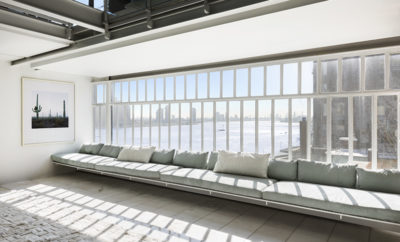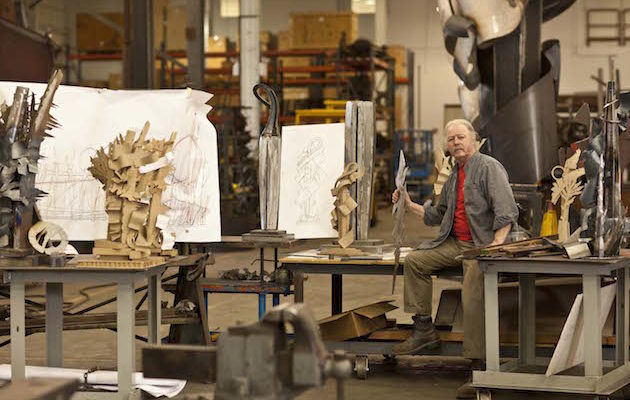 Albert Paley in his studio in Rochester, New York, 2012. Myers Creative Imaging Photo / Paley Studios Archive
Albert Paley in his studio in Rochester, New York, 2012. Myers Creative Imaging Photo / Paley Studios Archive
Feature
Albert Paley: Man of Steel
ALBERT PALEY IS A MAN OF MANY PARTS. Depending on whom you ask, he is a celebrated designer of distinctive art jewelry; an internationally famous designer of forged metal furniture and decorative objects; a crafter of ornamental architecture; or a sculptor of massive site-specific works. But no matter the category, Paley is probably the most important metal artisan of his generation. “Metal is a visual vocabulary,” he claims, and he has used that vocabulary to reinvigorate the ancient craft of ironworking, manipulating its rigid materials into powerfully seductive forms that explode with energy. Though clearly contemporary, Paley’s designs show a deep understanding of design history, and elements of rococo and art nouveau have often informed and enriched his work in a career that has lasted more than fifty years and is still going strong.
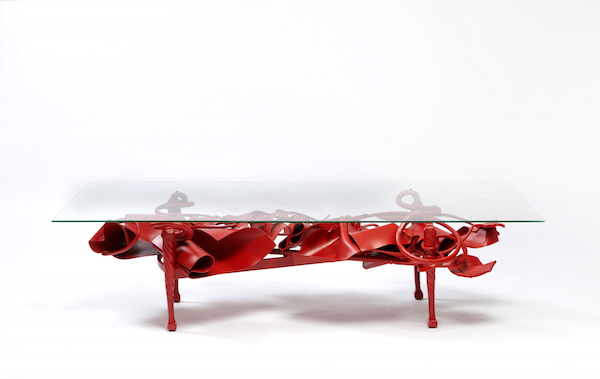
New Muse by Albert Paley, 2016, in painted steel shown here with a glass top. Courtesy of Wexler Gallery.
The Philadelphia-born artist graduated from Temple University’s Tyler School of Art in 1966 with a BFA in sculpture, but found pure sculpture “too elusive,” and was drawn to the discipline of metalworking. “It’s demanding, structured, more like my own personality,” he says, explaining why he went on to take his MFA in goldsmithing and began to make jewelry. “I approached goldsmithing as an art process, thinking of what I could bring to the history of ornamentation. I never thought of designing a collection.” Taking his inspiration from the form of the body rather than from current fashion, he devised bold geometric pendants, brooches, and rings in gold, silver, and such alloy metals as bronze. Not for the timid, the assertive pieces found a select clientele through word-of-mouth and private commissions.
While still a student, he was submitting work to exhibitions—and having it accepted. He came to the attention of Helen Drutt, a pioneer dealer in studio crafts, who gave him his first professional show in 1969, the same year he moved to Rochester, New York, to teach at the School for American Craftsmen (now the School for American Crafts) at the Rochester Institute of Technology, where he still holds a distinguished professorship. At the time, studio crafts were largely overlooked by most art museums, but Paley and his contemporaries—he mentions Dale Chihuly, Peter Voulkos, and Wendell Castle— gained recognition through exhibitions in university galleries, at symposia, and in the many publications reporting on the burgeoning movement.

Progression, 2012, in fabricated steel with a painted finish, as installed at SUNY Fredonia in 2015 for an exhibition of Paley’s work. Paley Studios Archive.
Having worked with iron to create jewelry-making tools, Paley began exploring its aesthetic possibilities on a larger scale, forging objects such as candlesticks and mirrors, and, later, tables. As one of relatively few craftsmen working in iron, he was invited to enter a 1972 Smithsonian Institution competition to design entrance gates for the Renwick Gallery in Washington, DC. His design, developed from forms that he had explored in jewelry, won the commission, and the resulting attention quickly led to other commissions for site-specific architectural projects, jump-starting a new phase of his career. (By this time, his studio and staff had expanded sufficiently to handle very large projects.) Interestingly, Paley sees a parallel between jewelry and architectural work: “As jewelry should bring a sense of personality to the wearer, so should pieces like the gates give personality to the architecture.” After the success of the gates, the Renwick staged an exhibition of Paley’s work, and that presentation of forged-iron pieces was the first public exposure of his furniture, the category for which he is best known in the design world.
Paley moved away from jewelry in 1977, leaving the work of studio craft for a larger and more public arena. As he explains it, “jewelry might be worn once or twice a year, but architectural pieces are seen every day.” Controverting the image of the reclusive artist, he has embraced being part of a community, interacting with architects and corporate clients. He has received commissions for gates and architectural ornaments, and, beginning in 1982 with a piece for Rochester’s Strong Museum, site-specific sculpture. With sixteen employees, the studio now completes two to three major sculptures each year—some more than a hundred feet tall—in steel, bronze, or aluminum (iron cannot be forged on that scale). Despite the introduction of technology for the largest pieces—CAD software, cutting machines, and hydraulic presses are called into play—most metal fabrication is handwork, and his own. “Everybody thinks I just design and others do the work . . . but every day I’m hands on.”
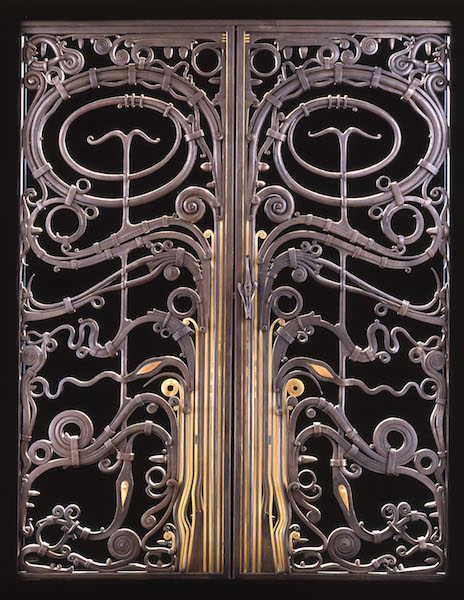
Portal Gates, 1974, in forged steel, brass, copper, and bronze, for the Renwick Gallery in Washington, DC. Paley Studios Archive.
Notwithstanding the large projects, he has continued to make furniture and decorative objects, the majority on commission and the rest for the prestigious galleries that represent him and show his work. After a 1998 residency at the Pilchuck Glass School, he has also worked with glass, creating forms at various glassworks and bringing them back to the studio to fuse with metal, in what he calls “a dialogue of opposites.” He balks at the idea of a definable style, but admits that “my sense of design, of composition, is identifiable.” Certainly, pieces like the thirteen dynamic curved and twisted steel forms, as much as twenty feet tall, that lined the medians of Park Avenue for several months in 2013 were identifiably Paley.
In the secondary market Paley pieces come up regularly in sales at Rago, Wright, and Phillips. In 2015 Wright sold a 1971 music stand, the first piece of furniture Paley made, for $56,250, and current prices for his celebrated tables tend to five figures. They range from small side tables and consoles to coffee tables and large dining tables, with tops made most often of glass, but sometimes of wood or marble.
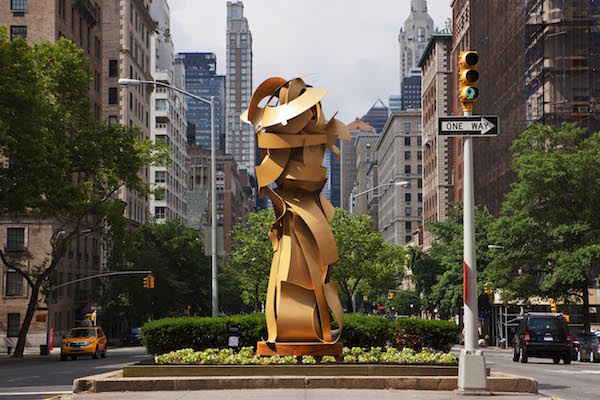
Envious Composure, 2012, in formed and fabricated steel with a painted finish, as installed on Park Avenue at 67th Street in Manhattan in 2013, one of thirteen works that comprised Paley on Park Avenue. Myers Creative Imaging Photo / Paley Studios Archive.
As museums now recognize studio crafts as art, Paley designs have entered the collections of more than two dozen museums, including such major institutions as the Renwick, Victoria and Albert, and the Metropolitan Museum of Art, and more than a dozen books, two documentary films, and several videos have documented his career. His work has been featured in numerous solo exhibitions and group shows. He’s also garnered honorary doctorates and numerous awards . . . though he’s especially proud of AIA’s Institute Honors (now the Collaborative Achievement) award, the first given to a metal sculptor.
Now seventy-four, with no thought of retiring, Paley has begun to look back on his career, which explains why he agreed to consign material from his archives for a special sale at Rago Auctions last January. He feels that the sale, and its catalogue, will help give his work historical context, so that people can better understand the objects and the materials. He hopes to place much of his archive in an institution that will encourage scholarship in metalwork. As for the breadth of his career and the complex operation that grew out of a one-man studio, Paley says, “I never expected all that to happen. All I ever wanted to do was make something.”

Pin from the Fibula series, 1971, in forged, fabricated, and oxidized sterling silver and gold, with coral, geode, and pearls. Courtesy of ragoarts.com.
You may also like...
E-NEWSLETTER
Advertisement
Advertisement

MODERN Magazine takes a fresh and intelligent approach as it examines buildings and interiors, furniture and objects, craft and art—delving into the creative process and offering sage advice for both the seasoned and novice collector or connoisseur.
© 2019 MODERN Magazine Media, LLC
LATEST NEWS
-
 DAVID SOKOL | April 29, 2019
DAVID SOKOL | April 29, 2019Method & Concept Shakes Up the Design Scene in Naples
Chad Jensen opened Method & Concept in Naples, Florida, in 2013 according to the Art Basel Miami Beach...
-
 ADRIAN MADLENER | April 24, 2019
ADRIAN MADLENER | April 24, 2019Collectible Milan
The annual Milan Design Week has long been the established benchmark of the industry. Comprised of the massive...
-
 JUDITH GURA | April 22, 2019
JUDITH GURA | April 22, 2019Breakout Efforts at the Corning Museum of Glass
Those who don’t consider glass a major art medium will think again after visiting a fascinating exhibition that...
-
 ANNA K. TALLEY | April 18, 2019
ANNA K. TALLEY | April 18, 2019Designers Envision the Future of Water at A/D/O
For Jane Withers, the London-based curator and writer who led Water Futures, design incubator A/D/O’s latest initiative, this...
-
 MATTHEW KENNEDY | April 18, 2019
MATTHEW KENNEDY | April 18, 2019Delving Deeper
Why an uncharacteristically meditative Memphis design mesmerized one resourceful bidder
-
 EZRA SHALES | April 16, 2019
EZRA SHALES | April 16, 2019Design Destination: Stockholm
TO STROLL ALONG STOCKHOLM’S HARBORS is to inhale the essentials of the city’s largesse and welcoming grandeur: the...


